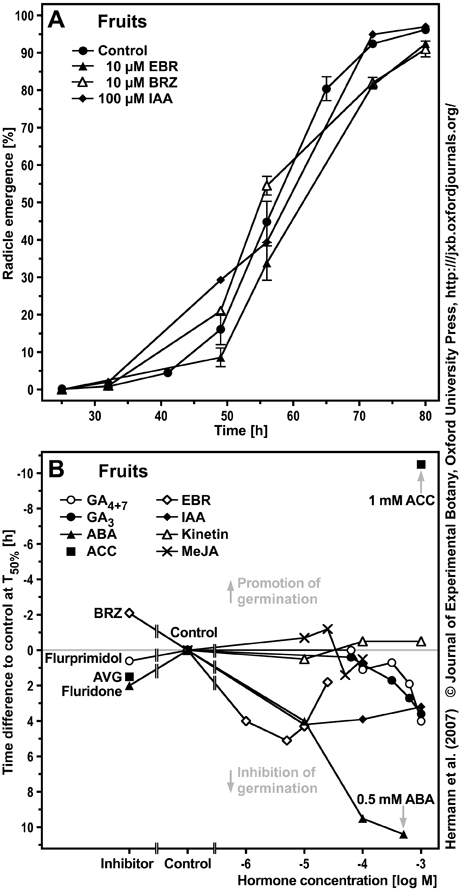Journal of Experimental Botany 58: 3047-3060 (2007)
1-Aminocyclopropane-1-carboxylic acid and abscisic acid during the germination of sugar beet (Beta vulgaris L.) - a comparative study of fruits and seeds
KWS SAAT AG, Grimsehlstr. 31, D-37555 Einbeck, Germany, Web: http://www.kws.de (J.M., U.F.)
Institute of Experimental Botany CAS, Rozvojová 263, CZ-16502 Prague 6, Czech Republic, Web: http://www.ueb.cas.cz/index_eng.htm (P.D., B.P., I.M.)
Received June 15, 2007; accepted June 25, 2007

Supplementary Figure S1. The effects of various plant hormones and hormone biosynthesis inhibitors on radicle emergence of Beta vulgaris fruits.
(A) Time course analysis of the effects of 24-epi-brassinolide (EBR), brassinazole (BRZ, BR biosynthesis inhibitor), and indole-3-acetic acid (IAA, auxin) on radicle emergence of fruit populations. The endogenous contents of the auxin indole-3-acetic acid (IAA) are higher in the dry sugar beet seeds compared to the pericarp (Table 1). In addition, endogenous BRs have been detected in dry sugar beet fruits (Schmidt et al., 1994). Supplementary Figure 1 shows that Neither EBR, nor treatment with brassinazole (BRZ, Asami et al., 2000), the inhibitor of BR biosynthesis, nor IAA treatment affected radicle emergence. In addition, EBR-permeation had no effect on sugar beet germination (data not shown).
(B) Dose-response curves for gibberellins (GA4+7, GA3), ABA, 1-aminocyclopropane-1-carboxylic acid (ACC, ethylene precursor), EBR, IAA, kinetin (cytokinin), methyljasmonate (MeJA), and the hormone biosynthesis inhibitors flurprimidol, fluridone, BRZ and aminoethoxyvinylglycine (AVG, ethylene biosynthesis inhibitor) on the radicle emergence of fruit populations. Based on these pharmacological experiments no effect of GA, BR, auxin, cytokinins or jasmonates on sugar beet radicle emergence was obtained. The times for 50 % radicle emergence (T50%) of the fruit populations were calculated for each treatment. The difference in hours of these T50% values to the corresponding controls are presented; a negative value (upper part of the graph) is therefore a promotion and a positive value (lower part of the graph) an inhibition of radicle emergence. Note the logarithmic scale for the hormone concentrations. Radicle emergence of fruit populations was scored over time; mean values ± SE (A) or T50% values (B) of at least one experiment with triplicates of 100 fruits are presented; conditions and statistics as in Fig. 2.
| Article in PDF format (1.3 MB) |
|
|
|
The Seed Biology Place
|
Webdesign Gerhard Leubner 2000
|